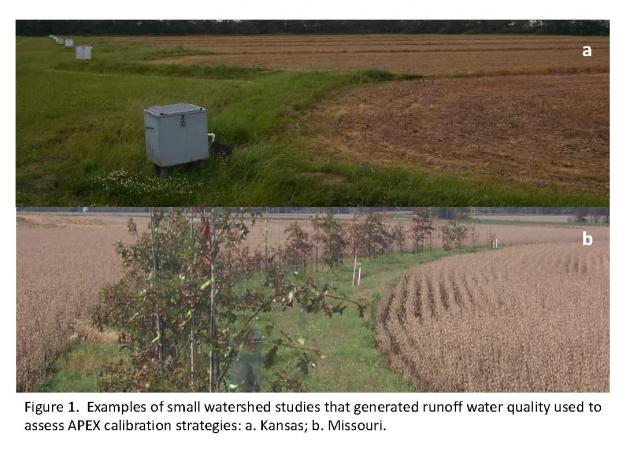Purpose
Phosphorus (P) indices are a key tool to minimize P loss from agricultural fields but there is insufficient water quality data to fully test them. Our goal is to use the Agricultural Policy/Environmental eXtender Model (APEX), calibrated with existing edge-of-field runoff data, to refine P indices and demonstrate their utility as a field assessment tool capable of protecting water quality. In this phase of the project our goal is to use existing small-watershed data from the Heartland Region (IA, KS, MO and NE) to determine the level of calibration needed for APEX before using the model to generate estimates of P loads appropriate for evaluating a P Index.
What did we do?
APEX model is designed to simulate edge-of-field water, sediment, and nutrient losses. Our analysis included data from 19 watersheds at four sites in the Heartland Region representing a range of hydrologic conditions and including grazing, tilled row-crop, and no-till row-crop management systems.
We evaluated two strategies to optimize settings of model parameters: i. a watershed-specific parameterization based on full calibration/validation comparing measured data with simulated results of the model for runoff volume, sediment load and P load, ii. a minimal parameterization approach based on best professional judgment (BPJ) consistent with using APEX when measured runoff, sediment and P data are not available for model calibration. Model fitting for strategy (i) was done using event data in each watershed. The two parameterization strategies were evaluated based on the fit of “annual” totals where data at each location were summed by year (total of 97 site-years). The Nash-Sutcliffe model efficiency and regression methods were used to quantify model fit.

What have we learned?
Full calibration provided excellent fit for runoff and total P (NSE>0.8 for each) and marginal fit for sediment (~0.3). In contrast, the BPJ resulted in unacceptable estimates of sediment and P load, and marginal fit for runoff volume (NSE~0.4). These results emphasize that failure to calibrate APEX with runoff and water quality data (the BPJ approach) will result in poor estimates of annual sediment and total P loads.
Future Plans
We are testing a regional parameterization strategy as another possible way to extend the APEX model to locations where there is no runoff and water quality data. The next phase of this project will then use appropriately calibrated models to generate the long-term estimates of P loss needed to evaluate P indices in IA, KS, MO and NE.
Authors
Dr. John A. Lory, Associate Professor of Extension, University of Missouri, Columbia, MO loryj@missouri.edu
Dr. Nathan Nelson, Associate Professor, Kansas State University, Manhattan, KS
Dr. Claire Baffaut, Research Hydrologist, USDA Agricultural Research Service, Columbia, MO
Dr. Anomaa Senaviratne, Post-doctoral Researcher, University of Missouri, Columbia, MO
Dr. Mike Van Liew, Watershed Modeling Specialist, University of Nebraska, Lincoln, NE
Ammar Bhandari, Doctoral Candidate, Kansas State University, Manhattan, KS
Dr. Antonio Mallarino, Professor, Iowa State University, Ames, IA
Dr. Matt Helmers, Professor, Iowa State University, Ames, IA
Dr. Ranjith Udawatta, Associate Research Professor, University of Missouri, Columbia, MO
Dr. Dan Sweeney, Professor, SE Agricultural Research Center, Kansas State University, Parsons, KS
Dr. Charles Wortmann, Professor, University of Nebraska, Lincoln, NE
Additional information
Please contact the authors for more information about this project.
Acknowledgements
This project is funded, in part, by a USDA-NRCS Conservation Innovation Grant.
The authors are solely responsible for the content of these proceedings. The technical information does not necessarily reflect the official position of the sponsoring agencies or institutions represented by planning committee members, and inclusion and distribution herein does not constitute an endorsement of views expressed by the same. Printed materials included herein are not refereed publications. Citations should appear as follows. EXAMPLE: Authors. 2015. Title of presentation. Waste to Worth: Spreading Science and Solutions. Seattle, WA. March 31-April 3, 2015. URL of this page. Accessed on: today’s date.

